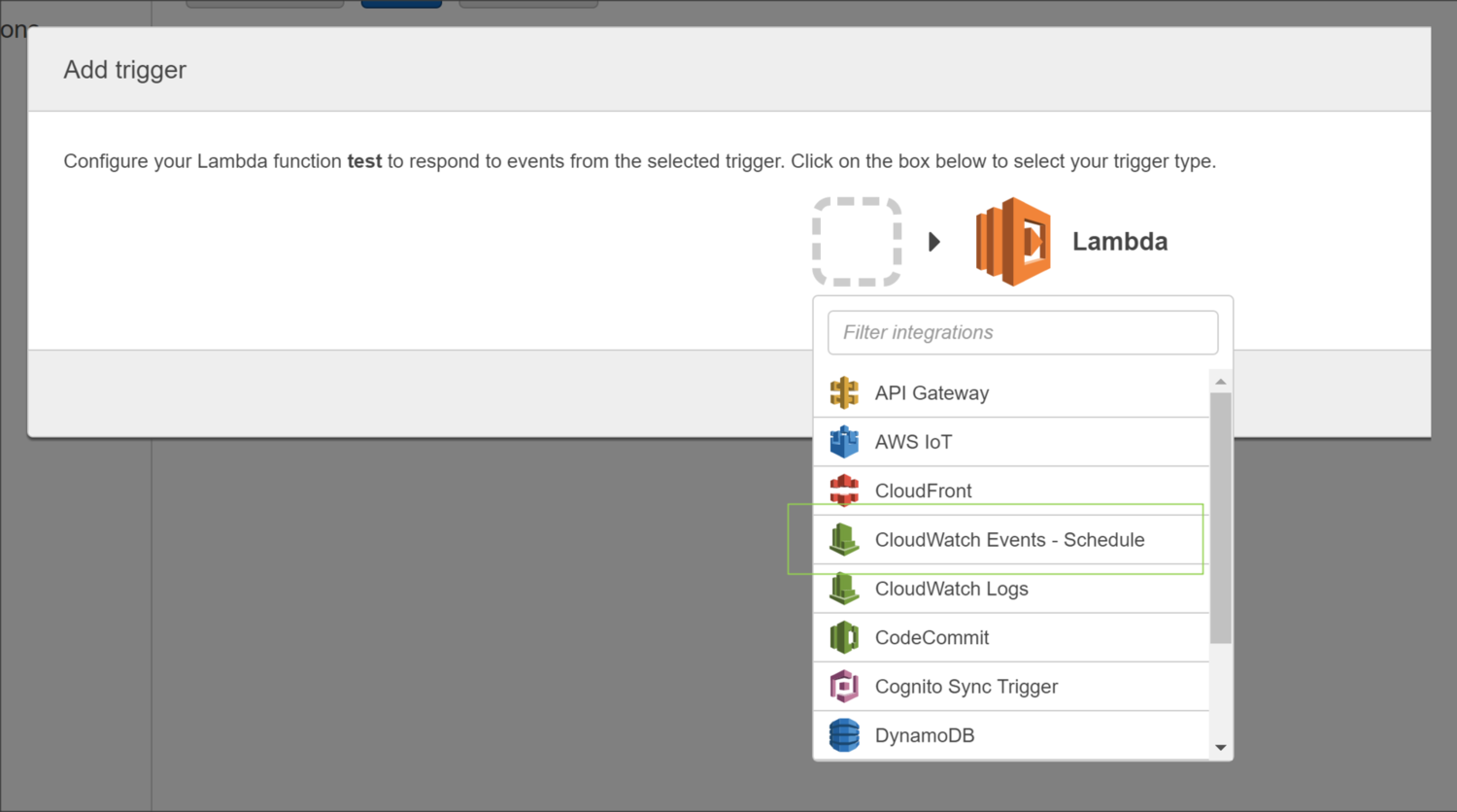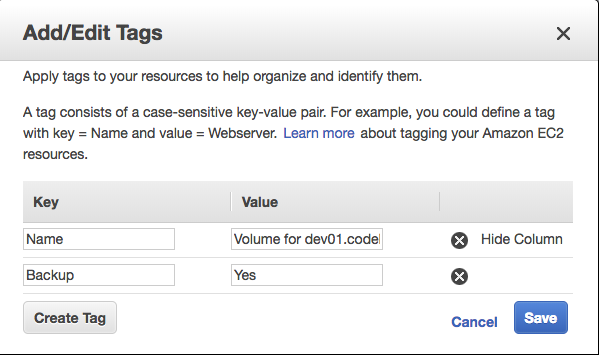标签:attach eve date man zone .com notice exce incr
In this post, we‘ll cover how to automate EBS snapshots for your AWS infrastructure using Lambda and CloudWatch. We‘ll build a solution that creates nightly snapshots for volumes attached to EC2 instances and deletes any snapshots older than 10 days. This will work across all AWS regions.
Lambda offers the ability to execute "serverless" code which means that AWS will provide the run-time platform for us. It currently supports the following languages: Node.js, Java, C# and Python. We‘ll be using Python to write our functions in this article.
We‘ll use a CloudWatch rule to trigger the execution of the Lambda functions based on a cron expression.
Before we write any code, we need to create an IAM role that has permissions to do the following:
In the AWS management console, we‘ll go to IAM > Roles > Create New Role. We name our role "ebs-snapshots-role".
For Role Type, we select AWS Lambda. This will grant the Lambda service permissions to assume the role.
On the next page, we won‘t select any of the managed policies so move on to Next Step.
Go back to the Roles page and select the newly created role. Under the Permissions tab, you‘ll find a link to create a custom inline policy.
Paste the JSON below for the policy:
{ "Version": "2012-10-17", "Statement": [ { "Effect": "Allow", "Action": [ "logs:*" ], "Resource": "arn:aws:logs:*:*:*" }, { "Effect": "Allow", "Action": "ec2:Describe*", "Resource": "*" }, { "Effect": "Allow", "Action": [ "ec2:CreateSnapshot", "ec2:DeleteSnapshot", "ec2:CreateTags", "ec2:ModifySnapshotAttribute", "ec2:ResetSnapshotAttribute" ], "Resource": [ "*" ] } ] }
Now, we can move on to writing the code to create snapshots. In the Lambda console, go to Functions > Create a Lambda Function -> Configure function and use the following parameters:
In our code, we‘ll be using Boto library which is the AWS SDK for Python.
Paste the code below into the code pane:
# Backup all in-use volumes in all regions import boto3 def lambda_handler(event, context): ec2 = boto3.client(‘ec2‘) # Get list of regions regions = ec2.describe_regions().get(‘Regions‘,[] ) # Iterate over regions for region in regions: print "Checking region %s " % region[‘RegionName‘] reg=region[‘RegionName‘] # Connect to region ec2 = boto3.client(‘ec2‘, region_name=reg) # Get all in-use volumes in all regions result = ec2.describe_volumes( Filters=[{‘Name‘: ‘status‘, ‘Values‘: [‘in-use‘]}]) for volume in result[‘Volumes‘]: print "Backing up %s in %s" % (volume[‘VolumeId‘], volume[‘AvailabilityZone‘]) # Create snapshot result = ec2.create_snapshot(VolumeId=volume[‘VolumeId‘],Description=‘Created by Lambda backup function ebs-snapshots‘) # Get snapshot resource ec2resource = boto3.resource(‘ec2‘, region_name=reg) snapshot = ec2resource.Snapshot(result[‘SnapshotId‘]) volumename = ‘N/A‘ # Find name tag for volume if it exists if ‘Tags‘ in volume: for tags in volume[‘Tags‘]: if tags["Key"] == ‘Name‘: volumename = tags["Value"] # Add volume name to snapshot for easier identification snapshot.create_tags(Tags=[{‘Key‘: ‘Name‘,‘Value‘: volumename}])
The code will create snapshots for any in-use volumes across all regions. It will also add the name of the volume to the snapshot name tag so it‘s easier for us to identify whenever we view the list of snapshots.
Next, select the role we created in the Lamba function handler and role section.
The default timeout for Lambda functions is 3 seconds, which is too short for our task. Let‘s increase the timeout to 1 minute under Advanced Settings. This will give our function enough time to kick off the snapshot process for each volume.
Click Next then Create Function in the review page to finish.
Navigate to the Triggers tab and click on Add Trigger which brings up the following window:

Selecting CloudWatch Event - Schedule from the dropdown list allows us to configure a rule based on a schedule. It‘s important to note that the times listed in the cron entry are in UTC.
You‘ll be prompted to enter a name, description, and schedule for the rule.
It‘s important to note that the times listed for the cron expression are in UTC. In the example below, we are scheduling the Lambda function to run each weeknight at 11pm UTC.
We can test our function immediately by click on the Save and Test button in the function page. This will execute the function and show the results in the console at the bottom of the page.

After verifying that the function runs successfully, we can take a look at the CloudWatch logs by clicking on the link shown in the Log Output section.
You‘ll notice a Log Group was created with the name /aws/lambda/ebs-create-snapshots. Select the most recent Log Stream to view individual messages:
11:00:19 START RequestId: bb6def8d-f26d-11e6-8983-89eca50275e0 Version: $LATEST 11:00:21 Backing up volume vol-0c0b66f7fd875964a in us-east-2a 11:00:22 END RequestId: bb6def8d-f26d-11e6-8983-89eca50275e0 11:00:22 REPORT RequestId: bb6def8d-f26d-11e6-8983-89eca50275e0 Duration: 3256.15 ms Billed Duration: 3300 ms Memory Size: 128 MB Max Memory Used: 40 MB
Let‘s take a look at how we can delete snapshots older than the retention period which we‘ll say is 10 days.
Before using the code below, you‘ll want to replace account_id with your AWS account number and adjust retention_days according to your needs.
# Delete snapshots older than retention period import boto3 from botocore.exceptions import ClientError from datetime import datetime,timedelta def delete_snapshot(snapshot_id, reg): print "Deleting snapshot %s " % (snapshot_id) try: ec2resource = boto3.resource(‘ec2‘, region_name=reg) snapshot = ec2resource.Snapshot(snapshot_id) snapshot.delete() except ClientError as e: print "Caught exception: %s" % e return def lambda_handler(event, context): # Get current timestamp in UTC now = datetime.now() # AWS Account ID account_id = ‘1234567890‘ # Define retention period in days retention_days = 10 # Create EC2 client ec2 = boto3.client(‘ec2‘) # Get list of regions regions = ec2.describe_regions().get(‘Regions‘,[] ) # Iterate over regions for region in regions: print "Checking region %s " % region[‘RegionName‘] reg=region[‘RegionName‘] # Connect to region ec2 = boto3.client(‘ec2‘, region_name=reg) # Filtering by snapshot timestamp comparison is not supported # So we grab all snapshot id‘s result = ec2.describe_snapshots( OwnerIds=[account_id] ) for snapshot in result[‘Snapshots‘]: print "Checking snapshot %s which was created on %s" % (snapshot[‘SnapshotId‘],snapshot[‘StartTime‘]) # Remove timezone info from snapshot in order for comparison to work below snapshot_time = snapshot[‘StartTime‘].replace(tzinfo=None) # Subtract snapshot time from now returns a timedelta # Check if the timedelta is greater than retention days if (now - snapshot_time) > timedelta(retention_days): print "Snapshot is older than configured retention of %d days" % (retention_days) delete_snapshot(snapshot[‘SnapshotId‘], reg) else: print "Snapshot is newer than configured retention of %d days so we keep it" % (retention_days)
The function we wrote for creating snapshots used a filter when calling ec2.describe_volumes that looked for status of in-use:
result = ec2.describe_volumes( Filters=[{‘Name‘: ‘status‘, ‘Values‘: [‘in-use‘]}])
We can also create tags on volumes and filter by tag.
Suppose we wanted to backup only the volumes that had a specific tag named "Backup" with a value of "Yes".
First, we create a tag for each volume by right-clicking on the volume and selecting Add/Edit Tags

Next, we modify the script and use the following line for describe_volumes:
result = ec2.describe_volumes( Filters=[{‘Name‘:‘tag:Backup‘, ‘Values‘:[‘Yes‘]}] )
Excluding certain volumes using tags is a bit different. The Filters parameter of describe_volumes is for inclusion only. So we cannot use that to tell the script to exclude specific volumes.
Suppose we wanted to backup all volumes EXCEPT ones with a tag named "Backup" with a value of "No".
First, we create a tag for each volume by right-clicking on the volume and selecting Add/Edit Tags

Next, we modify the script and manually filter the volumes inside the loop:
# Backup all volumes all regions # Skip those volumes with tag of Backup=No import boto3 def lambda_handler(event, context): ec2 = boto3.client(‘ec2‘) # Get list of regions regions = ec2.describe_regions().get(‘Regions‘,[] ) # Iterate over regions for region in regions: print "Checking region %s " % region[‘RegionName‘] reg=region[‘RegionName‘] # Connect to region ec2 = boto3.client(‘ec2‘, region_name=reg) # Get all volumes in all regions result = ec2.describe_volumes() for volume in result[‘Volumes‘]: backup = ‘Yes‘ # Get volume tag of Backup if it exists for tag in volume[‘Tags‘]: if tag[‘Key‘] == ‘Backup‘: backup = tag.get(‘Value‘) # Skip volume if Backup tag is No if backup == ‘No‘: break print "Backing up %s in %s" % (volume[‘VolumeId‘], volume[‘AvailabilityZone‘]) # Create snapshot result = ec2.create_snapshot(VolumeId=volume[‘VolumeId‘],Description=‘Created by Lambda backup function ebs-snapshots‘) # Get snapshot resource ec2resource = boto3.resource(‘ec2‘, region_name=reg) snapshot = ec2resource.Snapshot(result[‘SnapshotId‘]) instance_name = ‘N/A‘ # Fetch instance ID instance_id = volume[‘Attachments‘][0][‘InstanceId‘] # Get instance object using ID result = ec2.describe_instances(InstanceIds=[instance_id]) instance = result[‘Reservations‘][0][‘Instances‘][0] print instance # Find name tag for instance if ‘Tags‘ in instance: for tags in instance[‘Tags‘]: if tags["Key"] == ‘Name‘: instance_name = tags["Value"] # Add volume name to snapshot for easier identification snapshot.create_tags(Tags=[{‘Key‘: ‘Name‘,‘Value‘: instance_name}])
Automated EBS Snapshots using AWS Lambda & CloudWatch
标签:attach eve date man zone .com notice exce incr
原文地址:https://www.cnblogs.com/qiandavi/p/9563329.html